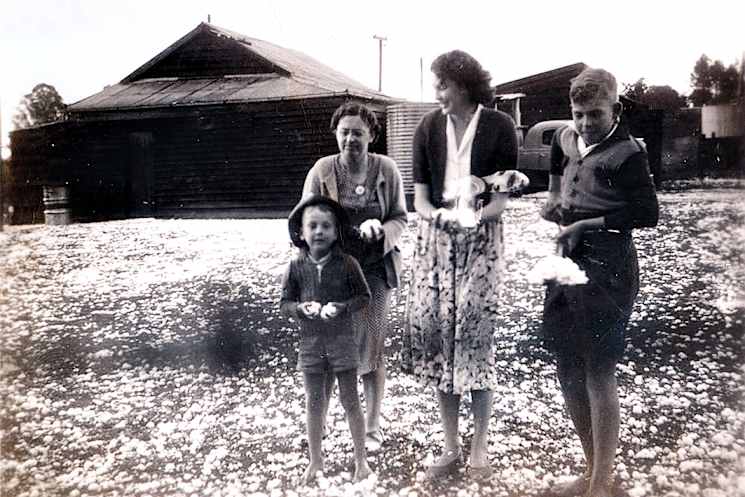
It wasn’t the worst hailstorm that Marburg residents experienced, that would come two years later, however our photo shows the Dance family in the ‘ice like snow’ on the ground in front of their Marburg Bakery following a storm in 1947. Photo: PICTURE IPSWICH
AN eerie fog was rising when Marburg residents emerged from their homes in town and out on the farms late one afternoon in November 1949.
The air was moist and cold in sharp contrast to the sweltering heat of less than an hour earlier.
Many residents were dazed from the deafening cacophony caused by wind driven hail stones as big as cricket balls smashing into iron roofs combined with the intermittent crash of trees and heavy branches, the crack of breaking window panes and the roar of the wind.
The epicentre of that wild storm on Sunday, November 13, hovered around Marburg, Rosewood and Tallegalla.
In reports that appeared in newspapers in the days that followed, those who lived through the tumult reported that the storm had hit the Marburg area at 4.00pm.
“Heralded by nasty looking greenish-black clouds and fierce rolls of thunder, the storm broke in the Marburg district about 4 o’clock, and for more than half an hour, rain and hail pelted down relentlessly,” one reporter wrote.
“The noise of the hail smashing down on the iron roofs was so great that it was impossible to hear anybody talking in a house without bellowing.”
As the district was dependent on its farms, the state of the crops appeared first in the stories which were published.
“Maize, which is just in the tasselling stage, suffered heavily from the lashing.
“Jagged segments of ice sliced through the tender green stalks like a knife through soft butter. Tomatoes were smashed to a pulp: grapes were ripped from the vines, battered and bruised; and vegetables, for which the district is justly famed, were mutilated or ruined completely.”
Many homes and sheds were also damaged.
One report noted: “Buildings constructed of fibro cement or old iron were subjected to a severe test and more than one bore honourable wounds after the battle. “In some cases fibro walls, were penetrated by large hail and heavy gauge iron was fractured by the concentrated barrage of icy pellets.
“Many windows were smashed.
“The hailstones varied in size from marbles to cricket balls, but in Marburg and Tallegalla they were consistently around the hen egg-cricket ball size.
“Large hail broke most of the 20 glass windows at the Marburg Roman Catholic Church, and it is expected that hundreds of panes in private homes will have to be replaced.
“In some places the hail punctured tanks, causing the water to gush out like a fountain.”
The eerie fog that rose from the ground after the storm was a factor of drifts of ice lying on ground that had only a short time before being heated by the sun.
The report continued: “An hour after the storm had passed at Marburg, hailstones were piled a foot deep in drains and against buildings and fences.
“In some cases the drift was much higher and more extensive.
“The steam that arose from the ground resembled that of a heavy fog. One Marburg resident, who is among dozens of heavy losers, said that it was the worst hailstorm the district had experienced for more than 40 years.”
A Tallegalla farmer was still coming to terms with his losses when he was interviewed by one reporter.
“One hailstone crashed through a corrugated fibro wall, and left a hole as large as a man’s fist; while heavy gauge galvanised iron was fractured and torn in some places.
“When the storm was at its height the ground was carpeted with white like snow.
“My cows were in the yard waiting to be milked … they had lumps all over their ribs and bodies from contact with the stones and some were bleeding.”
Only between 25 and 40 points of rain was recorded but as the rain was driven sideways by the wind, residents believed the fall was much greater.





